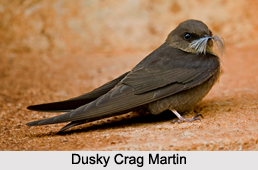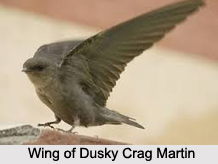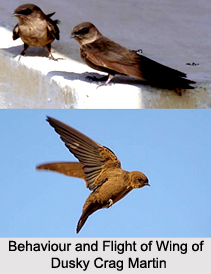 Dusky Crag Martin is an Indian bird that bears a scientific name "Ptyonoprogne concolor" is a small passerine bird in the swallow family.
Dusky Crag Martin is an Indian bird that bears a scientific name "Ptyonoprogne concolor" is a small passerine bird in the swallow family.
Structure of Dusky Crag Martin
Dusky Crag Martin is about 13 cm long with a broad body and wings, and a short square tail that has small white patches near the tips of most of its feathers. Dusky Crag Martin has sooty-brown upperparts and slightly paler under parts.
Category of Dusky Crag Martin
The two subspecies of Dusky Crag Martin are resident breeding birds in South Asia from the Indian subcontinent to south-western China and the northern parts of Thailand, Vietnam and Laos.
 Nests of Dusky Crag Martin
Nests of Dusky Crag Martin
Dusky Crag Martin nests under a cliff overhang or on a man-made structure, building a neat half-cup mud nest with a soft lining. Both adults incubate the two to four eggs and feed the chicks. This species does not form large breeding colonies, but it is more gregarious outside the breeding season.
Feeding of Dusky Crag Martin
Dusky Crag Martin feeds on a wide variety of insects that are caught as the martin flies near to cliff faces. It may be hunted by large bats as well as birds of prey, but its extensive and expanding range and large population mean that there are no significant conservation concerns.
 Behaviour of Dusky Crag Martin
Behaviour of Dusky Crag Martin
This small martin`s flight is typically slow and leisurely, but it is capable of considerable speed when required.
Call of Dusky Crag Martin
The calls of Dusky Crag Martin are similar to those of the Eurasian Crag Martin and include a soft chi, chi contact call and a twittering song.
Breeding Habitat of Dusky Crag Martin
The natural breeding habitat of Dusky Crag Martin occurs in hilly or mountainous country with cliffs, gorges and caves, with nesting typically up to an altitude of about 1,800 m (5900 ft), although up to 2,000 m (6,600 ft) in Thailand. Dusky Crag Martin also breeds in lowland areas utilising man-made structures as a substitute for natural precipices. Stone buildings such as old forts are particularly favoured, and the dusky crag martin can be found in urban areas including Mumbai, Maharashtra.
Pairing of Dusky Crag Martin
Dusky Crag Martin pairs typically nest alone, although in suitable locations several pairs may be quite close to each other. The natural nesting habitat is under ledges on cliff faces or river banks, but man-made structures are readily used. Stone buildings such as old hill forts, mosques and tombs are preferred, and other artificial sites include bridges, archways and culverts. Breeding has been reported in every month, but mainly in February and March, and again after the rains start in July and August; usually two broods are raised. The nest, built by both adults, is an open half-cup made of mud and lined with soft material such as feathers or dry grass. It is constructed under an overhang or in a crevice on a cliff or man-made structure, and is re-used for the second brood and in subsequent years.



















